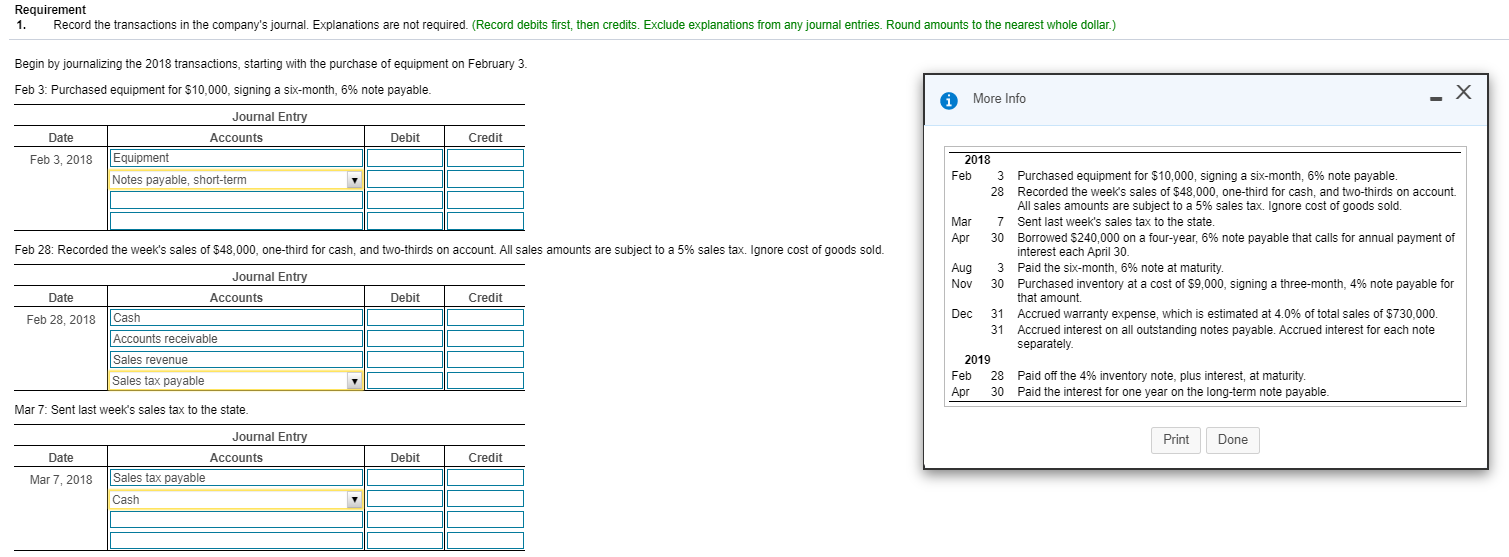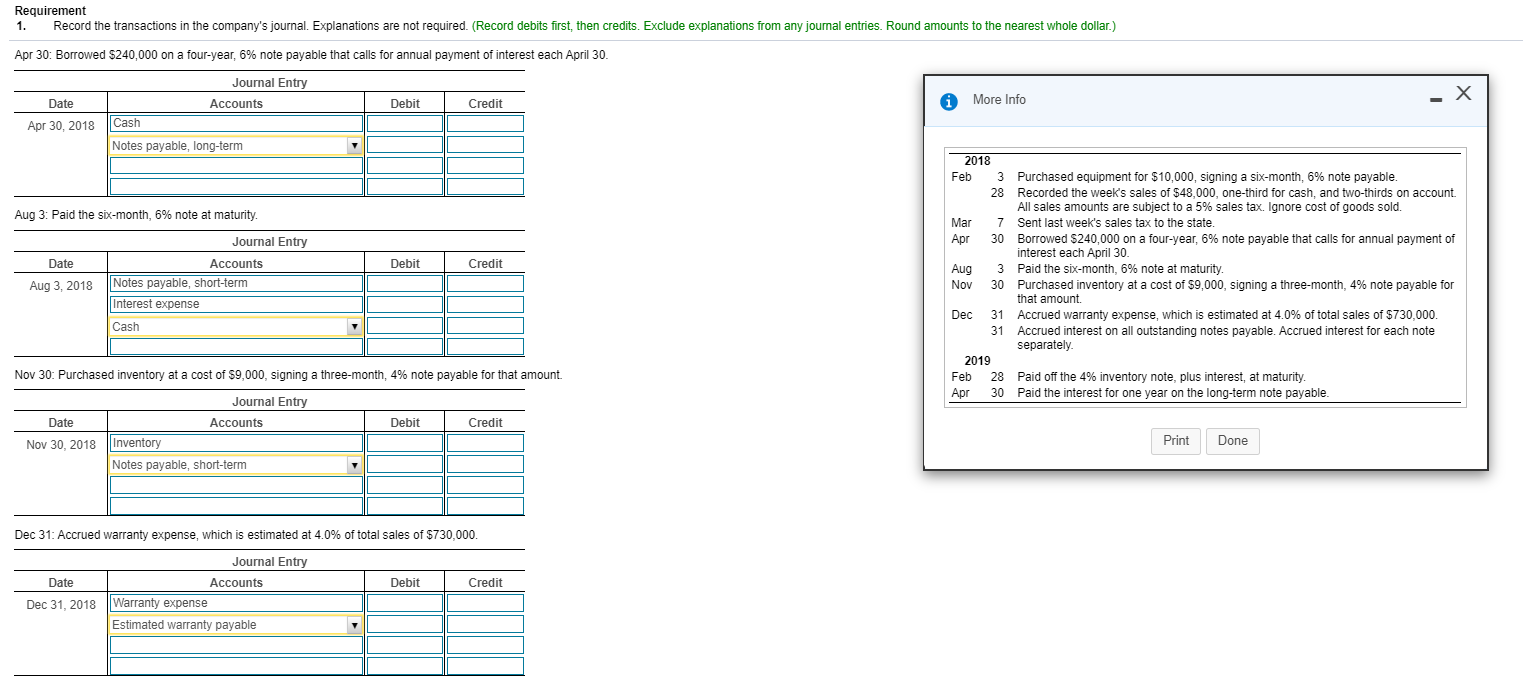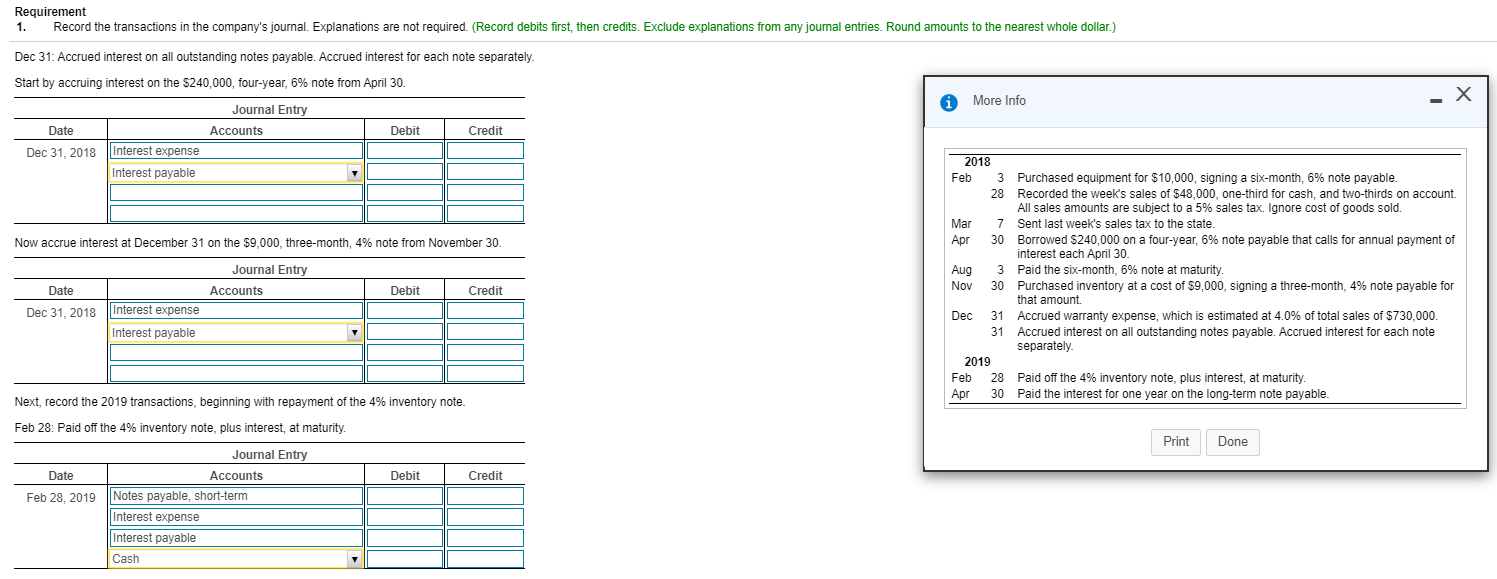Transaction information is in the pane to the right,
Thanks.




Requirement 1. Record the transactions in the company's journal. Explanations are not required. (Record debits first, then credits. Exclude explanations from any journal entries. Round amounts to the nearest whole dollar.) Begin by journalizing the 2018 transactions, starting with the purchase of equipment on February 3. Feb 3: Purchased equipment for $10,000, signing a six-month, 6% note payable. * More Info Date Debit Credit Journal Entry Accounts Equipment Notes payable, short-term Feb 3, 2018 Feb 28: Recorded the week's sales of $48,000, one-third for cash, and two-thirds on account. All sales amounts are subject to a 5% sales tax. Ignore cost of goods sold. 2018 Feb 3 Purchased equipment for $10,000, signing a six-month, 6% note payable. 28 Recorded the week's sales of $48,000, one-third for cash, and two-thirds on account. All sales amounts are subject to a 5% sales tax. Ignore cost of goods sold. Mar 7 Sent last week's sales tax to the state. 30 Borrowed $240,000 on a four-year, 6% note payable that calls for annual payment of interest each April 30. 3 Paid the six-month, 6% note at maturity. 30 Purchased inventory at a cost of $9,000, signing a three-month, 4% note payable for that amount. Dec 31 Accrued warranty expense, which is estimated at 4.0% of total sales of $730,000. 31 Accrued interest on all outstanding notes payable. Accrued interest for each note separately. 2019 Feb 28 Paid off the 4% inventory note, plus interest, at maturity. Apr 30 Paid the interest for one year on the long-term note payable Date Debit Credit Journal Entry Accounts Cash Accounts receivable Sales revenue Sales tax payable Feb 28, 2018 Mar 7: Sent last week's sales tax to the state. Print Done Debit Credit Date Mar 7, 2018 Journal Entry Accounts Sales tax payable Cash Requirement 1. Record the transactions in the company's journal. Explanations are not required. (Record debits first, then credits. Exclude explanations from any journal entries. Round amounts to the nearest whole dollar.) Apr 30: Borrowed $240,000 on a four-year, 6% note payable that calls for annual payment of interest each April 30. Debit Credit i More Info Date Apr 30, 2018 Journal Entry Accounts Cash Notes payable, long-term Aug 3: Paid the six-month, 6% note at maturity. Debit Credit Date Aug 3, 2018 Journal Entry Accounts Notes payable, short-term Interest expense 2018 Feb 3 Purchased equipment for $10,000, signing a six-month, 6% note payable. 28 Recorded the week's sales of $48,000, one-third for cash, and two-thirds on account. All sales amounts are subject to a 5% sales tax. Ignore cost of goods sold. Mar 7 Sent last week's sales tax to the state. 30 Borrowed $240,000 on a four-year, 6% note payable that calls for annual payment of interest each April 30. 3 Paid the six-month, 6% note at maturity. 30 Purchased inventory at a cost of $9,000, signing a three-month, 4% note payable for that amount. 31 Accrued warranty expense, which is estimated at 4.0% of total sales of $730,000. 31 Accrued interest on all outstanding notes payable. Accrued interest for each note separately. 2019 Feb 28 Paid off the 4% inventory note, plus interest, at maturity. Apr 30 Paid the interest for one year on the long-term note payable. Cash Nov 30: Purchased inventory at a cost of $9,000, signing a three-month, 4% note payable for that amount. Debit Credit Date Nov 30, 2018 Journal Entry Accounts Inventory Notes payable, short-term Print Done Dec 31: Accrued warranty expense, which is estimated at 4.0% of total sales of $730,000 Journal Entry Date Accounts Debit Credit Dec 31, 2018 Warranty expense Estimated warranty payable Requirement 1. Record the transactions in the company's journal. Explanations are not required. (Record debits first, then credits. Exclude explanations from any journal entries. Round amounts to the nearest whole dollar.) Dec 31: Accrued interest on all outstanding notes payable. Accrued interest for each note separately. Start by accruing interest on the $240,000, four-year, 6% note from April 30. A More Info Journal Entry Accounts Date Debit Credit Dec 31, 2018 Interest expense Interest payable Now accrue interest at December 31 on the $9,000, three-month, 4% note from November 30. Journal Entry 2018 Feb 3 Purchased equipment for $10,000, signing a six-month, 6% note payable. 28 Recorded the week's sales of $48,000, one-third for cash, and two-thirds on account. All sales amounts are subject to a 5% sales tax. Ignore cost of goods sold. 7 Sent last week's sales tax to the state. 30 Borrowed $240,000 on a four-year, 6% note payable that calls for annual payment of interest each April 30. 3 Paid the six-month, 6% note at maturity. 30 Purchased inventory at a cost of $9,000, signing a three-month, 4% note payable for that amount. Dec 31 Accrued warranty expense, which is estimated at 4.0% of total sales of $730,000. 31 Accrued interest on all outstanding notes payable. Accrued interest for each note separately. 2019 Feb 28 Paid off the 4% inventory note, plus interest, at maturity. Apr 30 Paid the interest for one year on the long-term note payable Date Accounts Debit Credit Dec 31, 2018 Interest expense Interest payable Next, record the 2019 transactions, beginning with repayment of the 4% inventory note. Feb 28: Paid off the 4% inventory note, plus interest, at maturity. Print Done Date Debit Credit Feb 28, 2019 Journal Entry Accounts Notes payable, short-term Interest expense Interest payable Cash Apr 30: Paid the interest for one year on the long-term note payable. Journal Entry Date Accounts Apr 30, 2019 Interest expense Interest payable Debit Credit Cash










